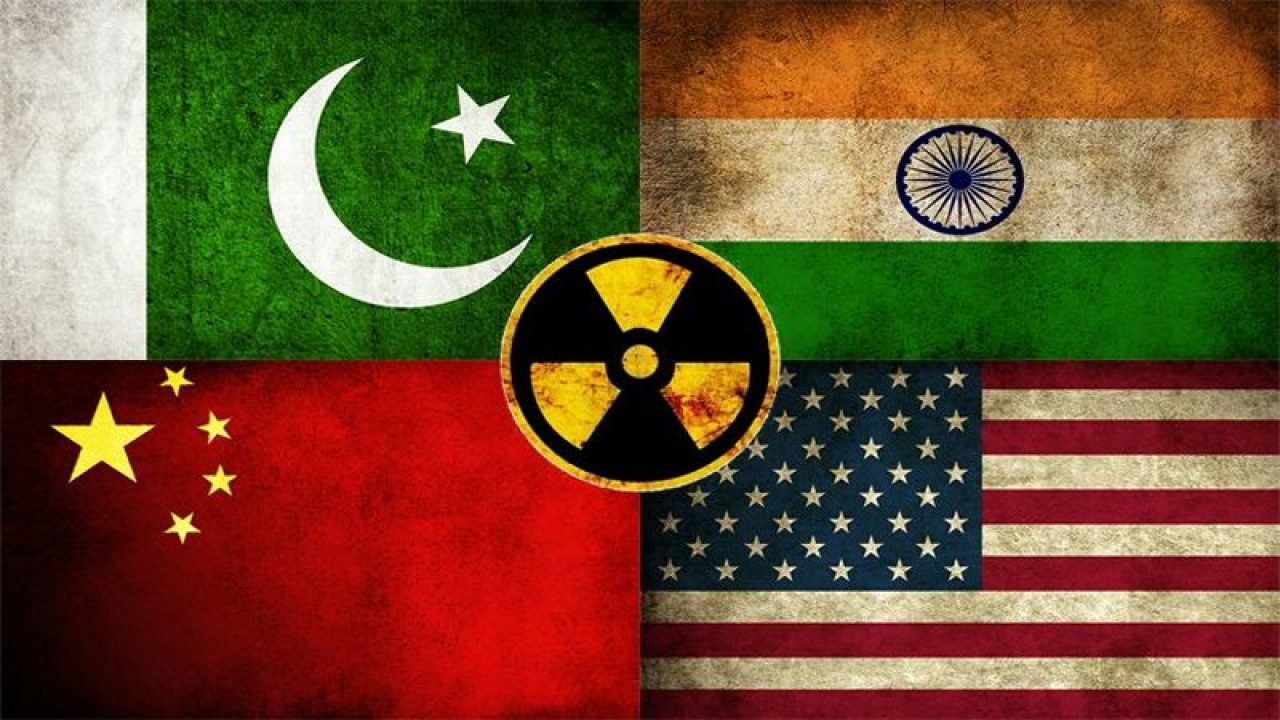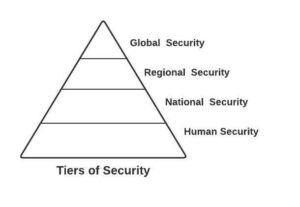
by Venkkat G. 12 September 2021
In midst of one of the most turbulent phases of world history in the early 1940s, at around the same time when Manhattan Project was conceptualized to develop the world’s first Nuclear weapon, an equally explosive idea gained ground in the Indian sub-continent. The Muslim League adopted the Pakistan Resolution of 1940 which called out for a separate homeland for the Muslims inhabiting the region. Similarly, exactly two years after the Hiroshima and Nagasaki bombings in August 1945 killed a total of around 2 lakh people, South Asia was ravaged by an even more destructive communal bomb that split the sub-continent into two and claimed the lives of anywhere between 2 lakh to 2 million individuals. Now moving into the Cold War era when the whole world was on the verge of a nuclear holocaust under the pretext of Nuclear Deterrence, the two neighboring states of India and Pakistan had already fought three major wars far away from the limelight.
However, the strategy of nuclear deterrence started gaining attention in South Asia following Indian defeat in the 1962 Indo-Chinese War and Pakistani humiliation in the 1971 Indo-Pak war, following which both the countries started with their nuclear weapons program. Finally in May 1998, both the countries tested their nuclear weapons back to back and declared themselves a de-facto nuclear weapons state, thus bringing the concept of nuclear deterrence to the center of security debates in the South Asian region. However even today, the question of whether nuclear deterrence contributes to enhancing security in South Asia or rather whether it enhances its insecurity remains hotly contested and will be taken up in this article.
Nuclear Deterrence enhancing security in South Asia
Most of the proponents of this proposition point their hands at the fact that there has been no major conventional war between the two countries of the likes of 1965 or 1971 ever since nuclear deterrence was firmly established. Apart from the brief border conflict at Kargil in 1999, intermittent ceasefire violations, and the recent Balakot incident, the conditions along Indo- Pakistan border have been fairly stable without any major territorial aggressions and unilateral change in the status quo. This is attributed to the fact that nuclear deterrence exponentially increases the potential cost of conflict through the doctrine of Mutually Assured Destruction (MAD), thereby prompting both parties to exercise cautious restrain even in situations that otherwise would have led to the declaration of war. This can evidently be seen from the strategic restraint exercised by the Government of India following the 2008 Mumbai attacks despite being under immense public pressure to give a befitting reply to Pakistan for its state-sponsored terrorism.
Another major important contribution which nuclearization has done for the South Asian region is that it has internationalized the bilateral dispute between India and Pakistan to the extent that it has become a matter of global concern. This puts an additional onus on the international community and other global powers to put external pressure on the two countries, and force them to come to the negotiating table. Any laxity in doing so could extend and exacerbate the existing crisis and potentially precipitate it into a nuclear war with far-reaching consequences for the entire global security. This can be seen from the manner in which the tense situation at borders following the 2001 Parliamentary attacks and the corresponding Operation Parakhram got diffused thanks to active intervention by the US. It made both the parties resume talks through back door negotiations and even promoted them to sign the 2004 Free Trade Agreement (SAFTA) to enhance the interdependence and connectivity between the two economies.
Now talking purely from the realist point of view, nuclear deterrence indisputably helps to bolster security at the state level at the very least. Realist scholars argue that the concept of security must be talked about primarily at the level of state rather than at the global or regional or even individual level. According to them, nation-states are the predominant actors in the present international political system and state security is of the utmost importance. Going by that rationale, it is only logical for the states to acquire nuclear capabilities to ensure the survival of their political regime, through which peace and stability can be ensured within its boundaries. This has a direct bearing on enhancing the security of the region in general and the security of its citizens in particular. To its credit, it can be fairly assessed that what gives Pakistan its present sense of security in the face of repeated jingoistic onslaughts from India, to the extent of threatening to divide it into four pieces, is its nuclear arsenal and the strategy of nuclear deterrence.
Nuclear Deterrence enhancing insecurity in South Asia
One of the strongest validations of this proposition lies in the very fact that the two neighbors went into an open war with each other at the Kargil sector in 1999, barely a year after testing of the nuclear weapons and establishing themselves as nuclear-weapon states. It is even justifiably argued that the strategy of nuclear deterrence directly contributed to the onset of war by bolstering the confidence of Pakistan in initiating unilateral changes to the territorial status quo. Sans the nuclear weapons, the threat of military retaliation by the conventionally superior India would have been too immense for the Pakistani state apparatus, just like what happened in the 1970s. Thus it can be said that while nuclear deterrence might have helped to prevent the escalation of the war by restraining the Indian response purely within its side of the LOC, it was also the primary cause for the initiation of war in the first place by emboldening Pakistan’s reckless behavior.
An equally significant shift that came associated with the adoption of nuclear deterrence is the increasing reliance on proxy wars. Under the garb of blanket immunity provided by the nuclear weapons, Pakistan has been successful in initiating low-intensity indirect conflict with the use of non-state actors and state-funded terrorist groups. The intensity of the covert operations is craftily managed and maintained within a threshold limit so that India cannot legally and rationally launch an all-out retaliation, be it conventional or nuclear. This strategy is famously remarked as the doctrine of ‘Bleed India with a Thousand Cuts’, and it involves state funding to terror groups, the conduct of cross border terrorism, funding insurgencies in Kashmir, fomenting unrest in the valley, and instigating the Muslim populace across the country. The results of this decades-long policy were directly witnessed during the 2001 Parliamentary attacks, 2008 Mumbai attacks, and more recently the attacks in Pathankot (2016), Uri (2016), and Pulwama (2019). This has directly led to the infringement of human security of individuals on both sides of the border and further exacerbated the general feeling of insecurity across the region. India in response has called off any meaningful conversation with its neighbor cum archenemy adhering to the maxim ‘terror and talks cannot go together and the regional co-operation initiatives like SAARC and SAFTA has hit a roadblock.
Another major security concern associated with the nuclear deterrence strategy is the very nature of the Pakistani state itself. It depicts a textbook example of what can be considered a military-bureaucratic- oligarchic state system. Although technically a democracy, the Pakistani deep state represented by ISI and the military holds considerable sway across the institutions of power and systems of decision making. More often than not the political establishment acts as a puppet of the deep state, and there have been ample instances where the military has called the shots without consulting or even considering the constitutional state apparatus in matters concerning national security and foreign policy. The most authoritative of all examples is that of the Kargil conflict which took place purely at the personal ambition of Musharraf without the knowledge of then Prime Minister Nawaz Sharif, who was soon overthrown in 1999 Pakistan coup d’etat. This makes Pakistan essentially a rogue state where its military can act irresponsibly to further its narrow agenda without virtually any responsibility towards its citizens, the constitutional apparatus, or the larger international community.
It is largely argued that Pakistan’s nuclear posture is centered on adopting the ‘madman with nukes’ strategy over the past two decades. It has openly proclaimed the doctrine of ‘first-use of nuclear weapons and ‘massive retaliation to any attack against the state, indirectly taking a dig at India. This deteriorates the security environment in the sub-continent and invokes the fear of a strategic miscalculation at the hands of Pakistani generals that could potentially end in a nuclear war between the neighbors. The series of miscalculations and miscommunications that ultimately led to the Cuban Missile Crisis of 1962 is a dire reminder of the same. Therefore even though states are not inherently suicidal, various unaccounted but significant factors could result in dangerous behavior by states leading to unfavorable outcomes for all.
It is very much possible that retaliation by the Indian side of the likes of surgical strike (2016) post-Uri attacks and Balakot airstrike (2019) post-Pulwama attacks could cross the ambiguous nuclear threshold and lead to a counter retaliation by the Pakistani side in the form of use of tactical nuclear weapons or a full-blown nuclear attack. Similarly, the possibility of accidental use of nuclear weapons can never be ruled out, particularly so in the case of third world states like India and Pakistan which lack a foolproof Nuclear command and control system. An even more disturbing aspect is the dimension of nuclear terrorism, whereby terrorist groups that are not accountable to the international system gain access to nuclear weapons. As the story of the AQ Khan network shows, the possibility of nuclear proliferation to rogue states and non-state actors is very real and forms an existential threat to the regional and global security architecture.
Nuclear Deterrence and Security: A balanced view
To give a more balanced view, it has to be said that nuclear deterrence contributes both to enhancing security and at the same time enhancing insecurity in the South Asian region. Broadly generalizing for the sake of convenience and understanding, it can be said that while nuclear deterrence enhances the security at the level of the state, it on the other hand enhances insecurity at the level of the individual, regional, and global security. Similarly, while it enhances the realist conception of security by enhancing the military and strategic security of the state, it on the other hand undermines the critical school’s conception of security which focuses on individual security, development, and freedom. Talking from a liberal perspective, the strategy of nuclear deterrence can help to enhance the security of the state and the overall peace and stability of the region and globe at large, provided the necessary international regimes are in place that can help to address the trust deficit and security dilemma between the nuclear powers.
However as far as the South Asian region is concerned, there is a lack of such effective bilateral or regional regimes that can regulate the conduct of nuclear security among its constituent states. The only provisions governing the nuclear relationship between India and Pakistan are the 1988 Non-Nuclear Aggression Agreement restraining attack on each other’s nuclear installations and 1999 Lahore Declaration to avoid accidental and unauthorized use of nuclear weapons. Apart from these limited provisions, there exists a general climate of enmity and hostility between the two nuclear neighbors cum arch enemies. The repeated threats issued by Pakistani generals on launching a nuclear attack against India, and the recent comments by Prime Minister Modi that India has not kept its nukes for Diwali but would give a ‘befitting reply’ if provoked highlights the overall mood in the sub-continent. Under such a heated environment of trust deficit, hatred, and vengeance, it can safely be concluded that the strategy of nuclear deterrence enhances the overall insecurity as far as the South Asian region is concerned.
Policy Recommendation
Now that said, what can be done to enhance the overall security environment in the South Asian region? It would be far too idealistic and novice to think that both the countries would give up on their nuclear arsenal one fine day and establish a Nuclear Free Zone (NFZ) in the region. Both Pakistan and India do have genuine security concerns, for the former from the latter, and for India a two-front war with Pakistan and China. The rationale of nuclear deterrence will continue to triumph as long as the security threats persist, and from the looks of it, for the foreseeable future. Therefore what is required is for the countries to shift their nuclear strategy to a more defensive posture of making nuclear weapons purely as a means for security rather than as a tool for power struggle and domination. The nuclear doctrine of India with its policy of ‘no-first use’, ‘minimum credible deterrence, and ‘non-use against non-nuclear states’ is widely perceived to be the ideal strategy conducive to balance the competing claims of state security versus regional security and peace.
Finally on a broader level, as the insights brought about by the Copenhagen school of security show, there is a dire need to ‘de-securitize’ the concept of security itself. This can prevent us from overemphasizing security more than what it is worth, and focus on things that really matter instead. In the recent 2019 Indian general elections, the Narendra Modi government came back to power primarily riding on the discourse of national security in the backdrop of the Balakot airstrike, showing how much the issue has become securitized. This virtually puts all the important issues of real-life concern like poverty, hunger, employment, education, and health, etc. on the back burner, seriously damaging the fight against these social ills. Indian Prime Minister Narendra Modi had once challenged Pakistan, “I want to say that India is ready for a war… India is ready for a war on poverty. Let both countries fight to see who would eradicate poverty first…” This is a war worth fighting for and the one which can help to enhance security at all levels, starting with the individual, to the state, to the region, and finally the global security.


